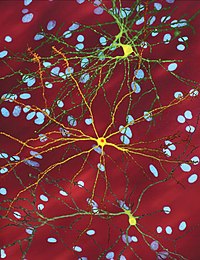
Photo from wikipedia
Huntington’s Disease (HD) is a dominantly inherited neurodegenerative disease for which the major causes of mortality are neurodegeneration-associated aspiration pneumonia followed by cardiac failure. mTORC1 pathway perturbations are present in… Click to show full abstract
Huntington’s Disease (HD) is a dominantly inherited neurodegenerative disease for which the major causes of mortality are neurodegeneration-associated aspiration pneumonia followed by cardiac failure. mTORC1 pathway perturbations are present in HD models and human tissues. Amelioration of mTORC1 deficits by genetic modulation improves disease phenotypes in HD models, is not a viable therapeutic strategy. Here, we assessed a novel small molecule mTORC1 pathway activator, NV-5297, for its improvement of the disease phenotypes in the N171-82Q HD mouse model. Oral dosing of NV-5297 over 6 weeks activated mTORC1, increased striatal volume, improved motor learning and heart contractility. Further, the heart contractility, heart fibrosis, and survival were improved in response to the cardiac stressor isoprenaline when compared to vehicle-treated mice. Cummulatively, these data support mTORC1 activation as a therapeutic target in HD and consolidates NV-5297 as a promising drug candidate for treating central and peripheral HD phenotypes and, more generally, mTORC1-deficit related diseases.
Journal Title: PLoS ONE
Year Published: 2022
Link to full text (if available)
Share on Social Media: Sign Up to like & get
recommendations!